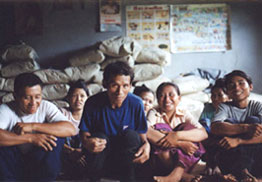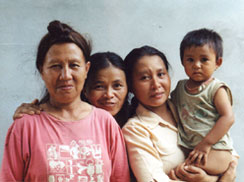| Background | |
| Hmong | |
| Khmu | |
| Yao | |
| Lahu | |
| Akha | |
| Stories | |
| Schedule | |
| Sponsorship | |
| Contact | |
| Lahu team | ||
| The theatre team live in Donekeo, a Black
Lahu village, in the lowlands of Ton Pheung district, on the crossroads
leading to the district capital and Houei Sai town (Bokeo). The village
moved there from the hills around 10 years ago. |
||
 |
 |
|
The Lahu are traditionally upland rice farmers. Those now living in the lowlands need time to adapt to new techniques of paddy land rice farming. This was a theme in the team’s rice bank play, which also covered the subject of opium and gender related issues. In the lowlands, the villagers’ memories of the past and of music and dance are fading. When asked, villagers said at first that they never danced nor did they know any songs. Due to the lack of entertainment in the village, the theatre teams rehearsals become village events, where young and old gather round and intently watch every step the actors make. The team uses this opportunity to tap into the community memory bank and recreate songs and dance, which can be used in the theatre to bring enjoyment to the audience. The Donekeo team can potentially make a very important contribution to Lahu villages not just in terms of education, but also in terms of entertainment and cultural revival. |
||
| Lahu history and culture | ||
The origins of the Lahu people are not
certain, but it is thought that they came to Laos from south western
China. Lahu is a Tibeto Burman language. This is another mountain-top
tribe with their houses on stilts, and a 'basement-corral' for their
many domestic animals: chickens, pigs, ducks, and buffaloes. Many
Lahu were once animists who converted to Christianity after contact
with missionaries. There
are now only around 10,000 Lahu living in Laos, mainly in the mountains,
a small number in comparison to the quarter million living in China
and 60,000 in Northern Thailand. In Laos, they can be divided into
two main groups the black and the white Lahu. The Lahu dress is like
many of the tribes based on indigo blue-black cloth, with bands of
red and white, and sometimes also blue, embroidery adorning the front
and arms. The women often tie their hair in a knot on their forehead.
Many Lahu groups have given up the daily use of their traditional
clothes, and only wear them on festive occasions. There
are now only around 10,000 Lahu living in Laos, mainly in the mountains,
a small number in comparison to the quarter million living in China
and 60,000 in Northern Thailand. In Laos, they can be divided into
two main groups the black and the white Lahu. The Lahu dress is like
many of the tribes based on indigo blue-black cloth, with bands of
red and white, and sometimes also blue, embroidery adorning the front
and arms. The women often tie their hair in a knot on their forehead.
Many Lahu groups have given up the daily use of their traditional
clothes, and only wear them on festive occasions.'Lahu', the name of their tribe, means 'hunter', and reveals their pride in their skills in hunting and trapping. They are also famous for their knowledge of herbal medicine. |
||